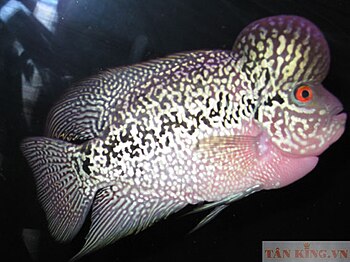What is a salvini?
Salvini cichlid or the yellow belly cichlid is also known as the Tri-color cichlid especially during breeding season. They do not appear to be extremely colorful however they show color variations with intensity at the time of spawning.
They are by nature moderately aggressive but gets really aggressive when breeding which is why smaller fishes should not be kept together with salvini's at this time. Ideally they can be tank mates with Jack Dempsey or a Red Devil cichlid.
 |
| Salvini male (Cichlasoma salvini) (Photo credit: Wikipedia) |
These species are quite known to hobbyist because of its hardiness and vividly beautiful coloration. It exudes spectacular colors of yellow, black, red, and sometimes even blue. They thrive well showing its stunning colors especially when kept with South American Cichlids of equal size and temperament.
What to feed the Salvini?
Feeding them is effortless because it will grab any type of foods given to them. They eat foods like flakes and pellets, or live foods, and frozen foods too. Always remember to add vegetables such as lettuce or zucchini in its meal every now and then to keep diet balance.
What are the preferable aquarium conditions for Salvini Fish?
A 50 gallon aquarium for a pair of salvini is adequate enough. Fill in water with a pH value between 6 and 8, a dH of 8 - 15, and a temperature of 70 - 84 degrees Fahrenheit. A constant water change of 25% - 30% is required at least once a week. The salvini aquarium water also needs a powerful filtration system. Moreover, salvini's tank should be decorated with lots of rocks, driftwood, and plants to provide them copious hiding places.
Live plants may be used in the tank since these species are not substrate digger or plant destroyers, actually it is said to be that salvini's color are enhanced deeply if kept in a well planted tank. Nevertheless, the salvini's should be kept in capacious aquarium. It is preferable to provide them a larger space for the cichlids to swim freely without the distraction of plants and other decorative items. Keep in mind that this variety is a bottom to mid swimmer fishes.
Salvini's are also an excellent parent to its babies thus the fry may be kept together with its parents as they grow. However, when kept in community tanks, the fry may be transferred to a new tank to avoid overcrowding.
Find out more on how to breed and care for the salvini cichlid's fry. Reading and understanding first the basic information about salvini's as well as the aquarium set-up and its water conditions gives hobbyist ideas on what are salvini cichlid fish and how to care for them. After which, they are ready to move on about how to go about breeding.
Lacey Bryant is a cichlid enthusiast and author, who has been caring for cichlids for over 15 years. She has been breeding Cichlids for years and it has become her passion to share her knowledge about their proper care. Article Source: EzineArticles |






